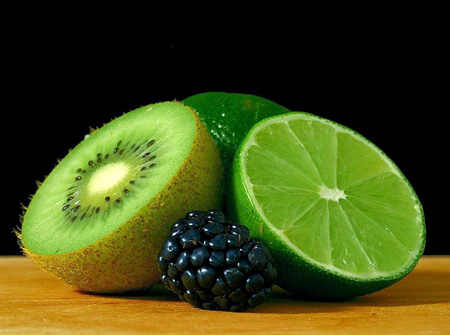|
|

Composition & Food Value of Fruits
|
| Just as fruits
vary in their composition, so do they vary in their food value. This
fact is clearly shown in table provided, which gives the percentage of food
substances contained in different fruits and the food value per pound,
in calories, that these fruits contain. |

| Fruit | Water | Protein | Fat | Carbohydrate | Mineral Matter | Food Value
per Pound,
in Calories |
| Apples, fresh | 84.6 | .4 | .5 | 14.2 | .3 | 290 |
| Apples, dried | 28.1 | 1.6 | 2.2 | 66.1 | 2.0 | 1,350 |
| Apricots, fresh | 85.0 | 1.1 | -- | 13.4 | .5 | 270 |
| Apricots, dried | 29.4 | 4.7 | 1.0 | 62.5 | 2.4 | 1,290 |
| Bananas | 75.3 | 1.3 | .6 | 22.0 | .8 | 460 |
| Blackberries | 86.3 | 1.3 | 1.0 | 10.9 | .5 | 270 |
| Cherries | 80.9 | 1.0 | .8 | 16.7 | .6 | 365 |
| Cranberries | 88.9 | .4 | .6 | 9.9 | .2 | 215 |
| Currants | 85.0 | 1.5 | -- | 12.8 | .7 | 265 |
| Dates | 15.4 | 2.1 | 2.8 | 78.4 | 1.3 | 1,615 |
| Figs, fresh | 79.1 | 1.5 | -- | 18.8 | .6 | 380 |
| Figs, dried | 18.8 | 4.3 | .3 | 74.2 | 2.4 | 1,475 |
| Grapefruit | 86.9 | .8 | .2 | 11.6 | .5 | 240 |
| Grapes | 77.4 | 1.3 | 1.6 | 19.2 | .5 | 450 |
| Huckleberries | 81.9 | .6 | .6 | 16.6 | .3 | 345 |
| Lemons | 89.3 | 1.0 | .7 | 8.5 | .5 | 205 |
| Muskmelons | 89.5 | .6 | -- | 9.3 | .6 | 185 |
| Nectarines | 82.9 | .6 | -- | 15.9 | .6 | 305 |
| Oranges | 86.9 | .8 | .2 | 11.6 | .5 | 240 |
| Peaches | 89.4 | .7 | .1 | 9.4 | .4 | 190 |
| Pears | 84.4 | .6 | .5 | 14.1 | .4 | 295 |
| Persimmons | 66.1 | .8 | .7 | 31.5 | .9 | 630 |
| Pineapple | 89.3 | .4 | .3 | 9.7 | .3 | 200 |
| Plums | 78.4 | 1.0 | -- | 20.1 | .5 | 395 |
| Pomegranates | 76.8 | 1.5 | 1.6 | 19.5 | .6 | 460 |
| Prunes, fresh | 79.6 | .9 | -- | 18.9 | .6 | 370 |
| Prunes, dried | 22.3 | 2.1 | -- | 73.3 | 2.3 | 1,400 |
| Raisins | 14.6 | 2.6 | 3.3 | 76.1 | 3.4 | 1,605 |
| Raspberries, red | 85.8 | 1.0 | -- | 12.6 | .6 | 255 |
| Raspberries, black | 84.1 | 1.7 | 1.0 | 12.6 | .6 | 310 |
| Rhubarb | 94.4 | .6 | .7 | 3.6 | .7 | 105 |
| Strawberries | 90.4 | 1.0 | .6 | 7.4 | .6 | 180 |
| Watermelon | 92.4 | .4 | .2 | 6.7 | .3 | 140 |
|
|
|
|
 |
| Email this info to Friend |
 |
Browse Pages
|
 Breads & Related Breads & Related
 Cakes & Related Cakes & Related
 Cookies Cookies
 Amazing Pies Amazing Pies
 Pastries Pastries
 Puddings Puddings
 Eggs Eggs
 Fruit Fruit
 Rice Rice
 Vegetarian Vegetarian
 Tasty Dips Tasty Dips
 Dressings Dressings
 Soups
& Related Soups
& Related
 Cooking With Kids Cooking With Kids
 Herbs & Spices Herbs & Spices
 Special Occasion Special Occasion
 Miscellaneous Miscellaneous
 Recommended Products Recommended Products |
 |

|
Did You Know?
|
There is a very marked difference
between ripe and green fruits as to their composition, flavor, texture,
palatability, and digestibility. Green fruits, containing more acid than
ripe ones, serve some purposes for which ripe fruits of the same variety
cannot be used so well. For instance, a very much better jelly can be
made from grapes that are not entirely ripe than from those which have
completely ripened.
Green fruits contain less sugar than do ripe ones,
and so they are more sour to the taste. In some cases, the carbohydrate
found in green fruits is partly in the form of starch, which in the
process of development is changed to sugar.
The cellulose of green
fruits, especially that distributed throughout the pulp of the fruit
itself, is usually tougher and harder than that which is found in the
same fruit after it has ripened.
The water content of fresh fruits is very high,
reaching 94 per cent. in some varieties. Dried fruits, on the other
hand, contain much less water, their content being in some cases as low
as 15 to 20 per cent. It naturally follows that the fruits low in water
are high in food value, while those containing considerable water have
in their composition less of the material that adds food value. The high
percentage of water in fresh fruits, together with the acids they
contain, accounts for the fact that these fruits are so refreshing.
Fruits of this kind, in addition to having this refreshing quality, help
to provide the necessary liquid in the diet.
|
 |
|



